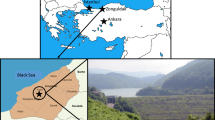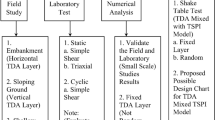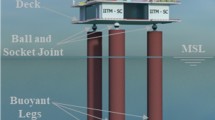Abstract
This work details the simulation of tsunami waves generated by seaquakes in the Manila Trench and their effect on fixed oil and gas jacket platforms in waters offshore North Borneo. For this study, a four-leg living quarter jacket platform located in a water depth of 63m is modelled in SACS v5.3. Malaysia has traditionally been perceived to be safe from the hazards of earthquakes and tsunamis. Local design practices tend to neglect tsunami waves and include no such provisions. In 2004, a 9.3M w seaquake occurred off the northwest coast of Aceh, which generated tsunami waves that caused destruction in Malaysia totalling US$ 25 million and 68 deaths. This event prompted an awareness of the need to study the reliability of fixed offshore platforms scattered throughout Malaysian waters. In this paper, we present a review of research on the seismicity of the Manila Trench, which is perceived to be high risk for Southeast Asia. From the tsunami numerical model TUNA-M2, we extract computer-simulated tsunami waves at prescribed grid points in the vicinity of the platforms in the region. Using wave heights as input, we simulate the tsunami using SACS v5.3 structural analysis software of offshore platforms, which is widely accepted by the industry. We employ the nonlinear solitary wave theory in our tsunami loading calculations for the platforms, and formulate a platform-specific risk quantification system. We then perform an intensive structural sensitivity analysis and derive a corresponding platform-specific risk rating model.
Similar content being viewed by others
References
Anat R, Nopporn S, 2009. Effect of Tsunamis generated in the Manila Trench on the Gulf of Thailand. Journal of Asian Earth Sciences, 36(2009), 56–66.
ARUP International Development, 2011. Characteristics of a safe and resilient community: community based disaster risk reduction study. International Federation of Red Cross and Red Crescent Societies.
Cham KL, Teh SY, Koh HL, 2006. Numerical simulations of Indian Ocean tsunami. TUNA-M2.
Duan WY, Zhao BB, 2013. Simulation of 2D underwater landslide induced tsunamis. Theoretical and Applied Mechanics Letters, 3, 03200.
Fenton JD, 1979. A high order cnoidal wave theory. Journal of Fluid Mechanics, 94, part 1, 129–161. DOI: http://dx.doi.org/10.1017/S0022112079000975
Hayashi M, Schirling P, 2015. Visual tsunami warning system. Proceedings of the Twenty-fifth (2015) International Ocean and Polar Engineering Conference, Kona, Big Island, Hawaii, USA, 865–872.
Imamura F, Shuno N, Goto C, 1988. Numerical simulations of the transoceanic propagation of tsunamis. Proceedings of 6th Congress Asian and Pacific Regional Division, 265–272.
Jaimes MA, Reinoso E, Ordaz M, Heurta B, Silva R, Mendoza E, Rodriguez JC, 2016. A new approach to probabilistic earthquake induced tsunami risk assessment. Ocean and Coastal Management, 119, 68–75. DOI: 10.1016/j.ocecoaman.2015.10.007
Jayaratne R, Premaratne B, Mikami T, Matsuba S, Shibayama T, Esteban M, Marriott M, 2015. Chapter 17: Destruction of coastal structures after the 2011 great east japan earthquake and tsunami handbook of coastal disaster mitigation for engineers and planners. Elsevier, 349–362. DOI: 10.1016/B978-0-12-801060-0.00017-4
Kim JH, Ahn SH, Ha TM, Cho YS, 2011. Development of a nested tsunami propagation model. Proceedings of the 21st (2011) International Offshore and Polar Engineering Conference, Hawaii, USA, 259–263.
Kirby S, Geist E, Lee HKW, Scholl D. Blakely R, 2006. Tsunami source Characterization for Western Pacific Subduction Zones: A Preliminary Report. USGS Tsunami Subduction Source Working Group 2005, Houston TX.
Koh HL, Teh SY, Liu PLF, Ismail AIM, Lee HL, 2009. Simulation of Andaman 2004 tsunami for assessing impact on Malaysia. Journal of Asian Earth Sciences, 36(1), 74–83. DOI: 10.1016/j.jseaes.2008.09.008
Koshimura S, Hayashi S, Gokon H, 2014. The Impact of the 2011 Tohoku earthquake tsunami disaster and implications to reconstruction. The Japanese Geotechnical Society, Soils and Foundations, Elsevier. Levin B, 2008. Physics of tsunamis. Springer, New York.
Liu PLF, Wang XM, Salisbury AJ, 2009. Tsunami hazard and early warning system in South China Sea. Journal of Asian Earth Sciences 36, 2–12.
Madsen PA, Fuhman DR, Schaffer HA, 2008. On the solitary wave paradigm for tsunamis. Journal of Geophysical Research, 113, C12012. DOI: 10.1029/2008JC004932
Megawati K, Shaw F, Sieh K, Huang Z, Wu TR, Lin Y, Pan TC, 2009. Tsunami hazard from the subduction megathrust of the South China Sea: Part I. Source characterization and the resulting tsunami. Journal of Asian Earth Sciences, 36(1), 13–20. DOI: 10.1016/j.jseaes.2008.11.012
Papazachos BC, Scordilis EM, Panagiotopoulos DG, Papazachos CB, Karakaisis GF, 2004. Global relations between seismic fault parameters and moment magnitude of earthquakes. Proceedings of the 10th International Congress, Thessaloniki 2004, Bulletin of the Geological Society of Greece, XXXVI, 1482–1489.
Takagi K, 1996. Interaction between tsunami and artificially floating island. International Journal of Offshore and Polar Engineering, 6(3), 171–176.
Teh SY, Koh HL, 2011. Tsunami simulation for capacity development. Proceedings of the International Multi Conference of Engineers and Computer Scientists 2011, 2, Hong Kong.
Vita-Finzi C, 2015. Misattributed tsunami 4: the 2014.04.01 Iquique (Chile) Mw 8.2 Earthquake. Proceedings of the Geologists Association, 126, 551-553.
Wu TR, 2012. Deterministic study on the potential large tsunami hazard in Taiwan. Journal of Earthquake and Tsunami, 6(3), 1250034. DOI: 10.1142/S1793431112500340.
Wu TR, Hui CH, 2009. Modelling tsunami hazards from Manila Trench to Taiwan. Journal of Asian Earth Sciences, 36, 21–28.
Zhang LF, Liao WL, Li JG, Wang QL, 2015. Estimation of the 2010 Mentawai tsunami earthquake rupture process from joint inversion of teleseismic and strong ground motion data. Geodesy and Geodynamics, 6(3), 180–186. http://dx.doi.org/10.1016/j.geog.2015.03.005
Author information
Authors and Affiliations
Corresponding author
Additional information
Foundation item: Universiti Teknologi PETRONAS Research Grant (No. 0153B2-A44)
Rights and permissions
About this article
Cite this article
Lee, H.E., Liew, M.S., Mardi, N.H. et al. Development of jacket platform tsunami risk rating system in waters offshore North Borneo. J. Marine. Sci. Appl. 15, 307–320 (2016). https://doi.org/10.1007/s11804-016-1367-5
Received:
Accepted:
Published:
Issue Date:
DOI: https://doi.org/10.1007/s11804-016-1367-5




